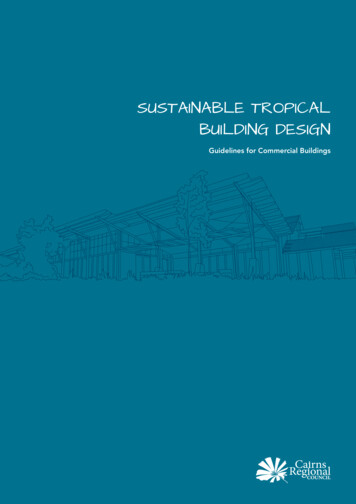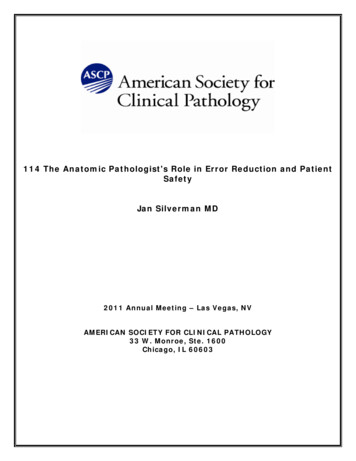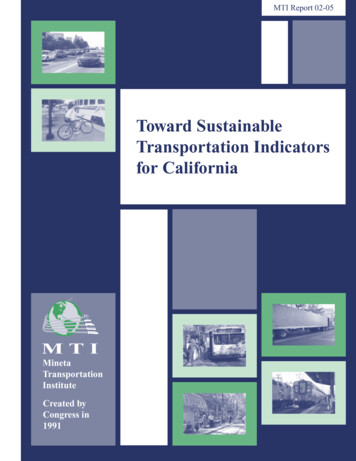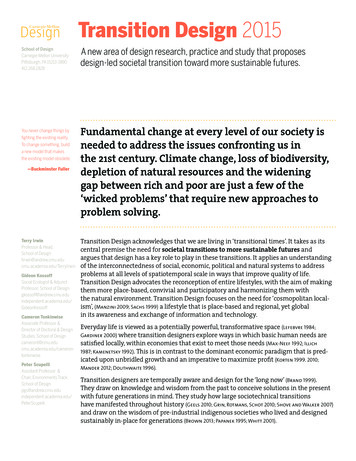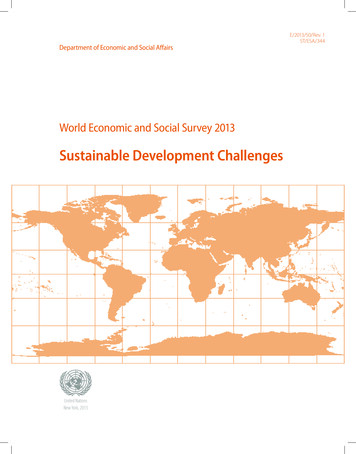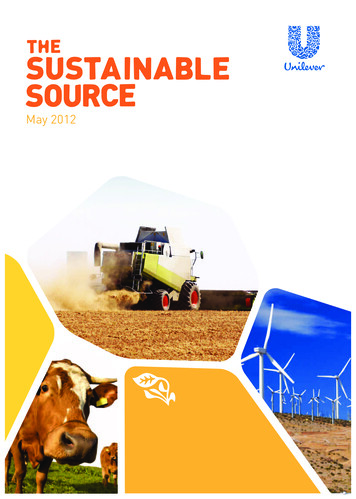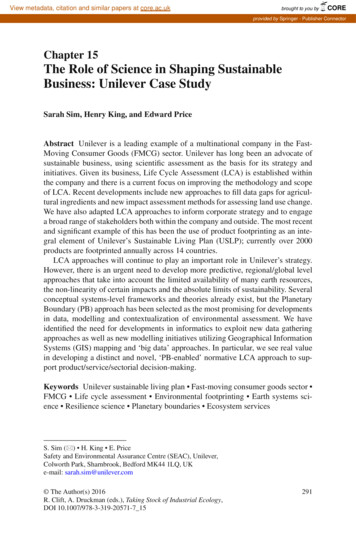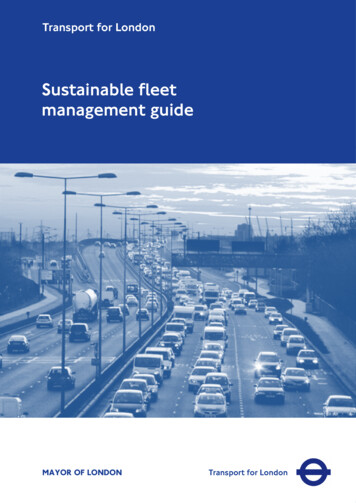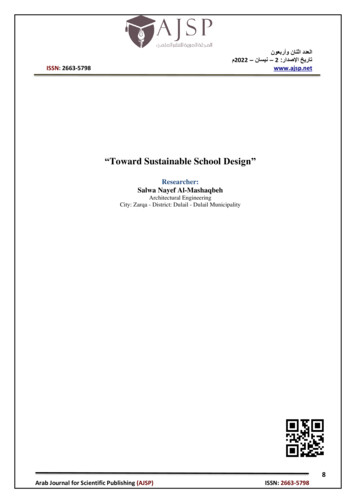
Transcription
العدد اثنان وأربعون م 2022 – – نيسان 2 : تاريخ اإلصدار www.ajsp.netISSN: 2663-5798“Toward Sustainable School Design”Researcher:Salwa Nayef Al-MashaqbehArchitectural EngineeringCity: Zarqa - District: Dulail - Dulail Municipality8Arab Journal for Scientific Publishing (AJSP)ISSN: 2663-5798
ISSN: 2663-5798 العدد اثنان وأربعون م 2022 – – نيسان 2 : تاريخ اإلصدار www.ajsp.netAbstract:“All sustainable developments goals come to education.” (Yousafzai, 2016)Recently, the sustainability concept has become a common concern in many fields. This widespread concept is, to achievethe sustainable development of societies. sustainability is a big umbrella that includes various concepts such as sustainabledevelopment, sustainable environment, sustainable cities, and sustainable architecture. The sustainable architecture includeslow energy consumption, high flexibility, and high efficiency in the use of resources to improve the quality of life andsustainable development, while reducing energy consumption and reducing environmental pollution, synchronizes itsconstituent elements to achieve sustainable development goals. the purpose of this paper is to endorse innovative strategiesof sustainable design associated with high levels of energy efficiency, environmental indoor quality, and performancestandards to enhance the Tariq bin Ziad school environment. The method of the paper will be a mixed-method approach thatwill be appropriate to evaluate the school data collection, which will combine a questionnaire survey to students and staff,and interviews with each administrator; to understand their overall satisfaction with the school's built environment and useprogram design-builder/Energy Plus to assess the Tariq bin Ziad school building energy simulation.Keywords: Education environment, Sustainability, Sustainable school, Design guidelines, Sustainable strategies.IntroductionThe term sustainability in the Oxford English Dictionary is derived from the Latin sustainer (tenere, to hold; sus, up).Dictionaries provide more than ten meanings for sustain, the main ones being to ―maintain", "support", or "endure‖ (Onions,1964). The World Commission on Environment and Development Sustainability defined the term as meeting the needs oftoday without compromising the ability of future generations to meet their own needs. (Haji Mohd. & Norhazarina , 2012).(Kilbert, 1994) Defined sustainable, it is the healthily built environment based on resource efficiency and ecologicalprinciples. (Vieria, 1993) Addressed sustainable strategies that look at a site’s natural land, water, air, and energy resourcesas integral aspects of the design. In addition, (Beyer, 2012) had emphasized that sustainability can be classified as wellbeing constructed human places that satisfy people's needs such as security, health, comfort, and spiritual well-being, byexploiting the local natural resources (materials, climate) without adversely impacting on the natural environment (resourcedepletion, pollution, waste). Nowadays, the term sustainability is used to describe human and natural systems relationshipsthat can be combined to survive the distant future.Research Problemstudents spend more time in their school than in their home environment. school as the building is mainly characterized by alow level of architectural quality and performance. This leads to high consumption of energy, and the indoor microclimatebecomes below comfort level. This results in the Lack of interaction between the schools and their environment and thefailure in non-exploitation of the natural environment. Paper has shown that poor indoor and outdoor environments cannegatively affect the health and development of students in school buildings.School buildings play a dual role: on one hand, they have to ensure adequate technical standards to all spaces usedby the students, and on the other, they have to improve the school environment by effectively communicating the criteria andstrategies of sustainable design.Research purposeThe purpose of this paper is to investigate indoor and outdoor school environmental qualities and document the presence orabsence of sustainable design elements in school design. This guides us to highlighting criteria, and strategies, which mustbe adopted in the sustainable design in Tariq bin Ziad School.Research Objective: The paper aims to promote criteria, and innovative strategies of sustainable design that combine high levels of energyefficiency, performance standards, and environmental indoor quality to incorporate building and its related systems. Providing guidelines for architects, designers, and managers in enhancing the current school environment to become asustainable environment in the future.Research HypothesisAdapting sustainability criteria and their implementation in Tariq bin Ziad School will reduce energy consumption in additionto providing a comfortable place for users.Research Significance The reduction of energy consumption and the possibility to meet the needs of students’ comfort. Improving performance levels of school, providing better conditions of use and consuming less. Satisfaction of the students with the school's built environment and adequately supported their daily activities. To make guidelines for an architect when designing a sustainable school.9Arab Journal for Scientific Publishing (AJSP)ISSN: 2663-5798
ISSN: 2663-5798 العدد اثنان وأربعون م 2022 – – نيسان 2 : تاريخ اإلصدار www.ajsp.netLiterature reviewPrinciples of Sustainable ArchitectureSustainable architecture is the means to "create a stable man-made environment" according to the general definition of GreenArchitecture, Echo Tech architecture, and Organic Tech architecture. In a general context, human architecture is designed toreduce damage to natural resources and energy consumption. The main objectives of sustainable architecture are: (Nazarian, 2015, pp. 47-48) Organizing the flexible and multifunctional actions; Maximizing the use of renewable energy; No adverse environmental impact on your site of living; Use the native form and by climatic conditions; Enhancing the quality of life.Sustainable buildingsSustainable Building is a comprehensive body; “whole building” way to design, construction, and operation. Sustainablebuildings whether are stated as green or high-performance buildings designed to: provide optimal environmental andeconomic performance; increase efficiencies thereby saving energy, water, and other resources; furnish satisfying,productive, and quality indoor spaces; use an environmentally better choice of materials; and educate building occupantsabout efficiency and conservation (Olson, Stephen , & Kellum, 2003).The OECD Project defined Sustainable buildings as buildings that have minimum negative impacts on the built andnatural environment, in terms of the building itself, its current setting and the broader regional and global settings. Sustainablebuilding is fully integrated, which attempts for integral performance (including economic, social, and environmentalperformance) in a comprehensive way. Thus, the rational use of natural resources and appropriate management of thebuilding stock will contribute to saving rare resources, reducing energy consumption, and improving environmental quality.The OECD project identified five objectives for sustainable buildings;1. Resource efficiency;2. Energy efficiency (including greenhouse gas emissions reduction);3. Pollution prevention (including indoor air quality and noise abatement);4. Harmonization with the environment;5. Integrated and systemic approaches.Sustainable building involves considering the whole life of buildings, taking environmental quality, functionalquality, and future values into account. Therefore, sustainable building design is the thoughtful integration of architecturewith electrical, mechanical, and structural engineering resources.Sustainable schoolsSustainable schools are the educational tool that brings together environmental education and community engagement.Sustainable schools create an environment where teachers have more chances to develop exclusive learning opportunitiesand students benefit through increased participation and productivity and improved problem-solving and critical thinkingskills of students (Gough, 2006). These collaborative actions encourage all members of the school community, which createsa culture of continuous learning, growth, and development (Alliance, 2018).Why sustainable schools are importantStudents spend the majority of their day in a school building during their most crucial developmental years. Therefore, theEducational program is essential for students. This program combines physical place and organizational culture that enhancesthe development of environmentally sensible global citizens. In this time of crucial growth, schools must be a space forcreative thinking, a source of inspiration, and a starting point for developing a sense of awareness and responsibility. Thejourney to that goal begins with educating students in a healthy and sustainable environment (Alliance, 2018). Figure 1 showsthe reported case studies that analyze the impact of environmental education on students.10Arab Journal for Scientific Publishing (AJSP)ISSN: 2663-5798
ISSN: 2663-5798 العدد اثنان وأربعون م 2022 – – نيسان 2 : تاريخ اإلصدار www.ajsp.netFigure1: Impact of Environmental Education on Students (NAAEE, 2011).11Arab Journal for Scientific Publishing (AJSP)ISSN: 2663-5798
العدد اثنان وأربعون م 2022 – – نيسان 2 : تاريخ اإلصدار www.ajsp.netISSN: 2663-5798Figure 2 Sustainable Strategies for Douglas Park School (Rolston, et al., 2012)Sustainable school building benefits the school district and community. These benefits are classified as Economicbenefits, Environmental benefits, and society benefits; Economic benefits include reduced life cycle and operating andmaintenance costs. Environmental benefits embrace improved energy and water efficiency, reduced pollution, and reducedlandfill waste. In addition, other benefits include improved health of students and staff, reduced absence, improved indoorair quality, and possibly increased test scores (Ohio Project, Energy, 2000). As a result, society benefits from the decreasedimpact on the environment and the increased comfort, health, and quality of life for building users.The following table shows the Benefits of Implementing a Whole-School Sustainability Program (Alliance, 2018).StudentsSchoolsPlanetSustainable strategies application revealeda positive impact because of environmentaleducation.The sustainable school uses 33%less energy and 32% less waterthan constructed school.Sustainable school is designed to teach andrepresent Eco-friendly initiatives that reduceour environmental impact.The sustainable school with natural lightsources reported major increases in exams.Sustainable schools save a lot ofbudgetsthatdischargeoperational costs.The sustainable school building is constructedwith renewable materials that decrease thereliance on fossil fuels, reducing carbonemissions.Studies reported students could ableequally engage in environmental educationregardless of where they fell on theintellectual field.Sustainable school improves thehealth of students and staff, andincrease indoor air quality.Green roofs last longer than typical roofs,reducing the amount of waste produced fromreplacement that is more frequent.12Arab Journal for Scientific Publishing (AJSP)ISSN: 2663-5798
العدد اثنان وأربعون م 2022 – – نيسان 2 : تاريخ اإلصدار www.ajsp.netISSN: 2663-5798Studies reported increased studentengagement in class, which is located in asustainable environment.The sustainable school receivesdirect and indirect savings fromincreased efficiency, higherteacher retention, and lowerhealth costs.Sustainable schools motivate thegeneration of environmental issuesGeneral Characteristics of Sustainable SchoolDetermining the general characteristics of a sustainable school are important to develop and build a sustainable school design(Haji Mohd. & Norhazarina , 2012). So, The Centre of Green School under the U.S. Green Building Council had defined thesustainable school characteristics as the following: Saves energy and natural resources;enhancing indoor air quality;removes toxic materials from places where children learn and play;engage in daylighting strategies and improves classroom acoustics;minimizing the burden on municipal water and wastewater treatment;Encourages waste management efforts to benefit the local community and region;preserves fresh drinking water and helps manage stormwater runoff;Encourage recycling;Promote habitats protection;Reduced demand on local landfills.To achieve a Sustainable school model, strategies guidelines go well beyond design and engineering criteria for thebuildings, concentrate on land use, processes for construction and equipment installation, and operation and maintenancepractices. It includes design and engineering techniques to meet specific objectives, which are (Gough, 2006): Select the site of the school near public transportation to reduce pollution; locating a building on a green site to minimize its environmental impact and make the most of available natural light andsolar gain; Designing irrigation systems and indoor plumbing systems to conserve water; Designing energy and lighting systems thus conserving fossil fuels and maximizing the use of renewable resources; Selecting renewable materials that are non-toxic, biodegradable, and easily recycled; Designing an indoor environment that provides occupants with a comfortable temperature, good air quality, lighting, andacoustics (Haji Mohd. & Norhazarina , 2012).Air and ventilationIn a school building, where the main purpose is education and the development of intelligent activities. Students spend mostof the time in their school building: the existence of a lot number of occupants in an enclosed space results in a decrease inair quality leads to an increasing concentration of pollutants. Air pollution is one of the main causes of a decrease in the levelof comfort and attention paid by the users. Therefore, good ventilation is essential to remove the sources of pollution and tomaintain a high level of indoor comfort and save suitable indoor ventilation, favoring the necessary air change get fresh cleanair and eject the exhausted inside air, to improve the user's well-being (Becker, Goldberger, I, & Paciuk, 2007).Based on the extensive quantity of air that requires to be changed to create the best indoor comfort school buildings,whose goals are a high level of energy efficiency should be provided with passive ventilation systems equipped with efficientheat recovery units. This solution, attached with a careful sealing of all joints and openings where air could flow through,this systems allow to control the airflows and to reduce energy consumption (BOERI & LONGO, 2013).Efficient ventilation needs to take into account proper planning of the positioning and the size of all openings, andthe particular conditions of the site, such as the strength and the main direction of the wind. Proper natural ventilation needsthe existence of openings on the two opposite sides of a room for a quick air change and a generation of cross-flows. In thiscase, the opening ports are located at a lower level and can be smaller than the opening ports, usually in a higher position.Ventilation, both natural and mechanical, can be used as a cooling system during the summer and is useful for removing,during the night, part of the accumulated heat of building elements during the day (BOERI & LONGO, 2013) .13Arab Journal for Scientific Publishing (AJSP)ISSN: 2663-5798next
ISSN: 2663-5798 العدد اثنان وأربعون م 2022 – – نيسان 2 : تاريخ اإلصدار www.ajsp.netNatural lightIndoor lighting issue has great effects to achieve high levels of environmental quality and energy efficiency in a schoolbuilding. So, increased of using natural light in greater part and reduced using artificial sources, since both in the energybudget of a school building the consumptions resulting from the use of lighting systems are an item of relevant impact andfor the effects, the available natural light produces in terms of indoor comfort (BOERI & LONGO, 2013).Research Design (methodologies)Educational buildings need to stimulate student productivity and learning. This paper presents a mixed-method approach forestimating and optimizing the environmental comfort parameters of school buildings. Tariq bin Ziad School, Marka, Amman,analyzed and characterized to test the environmental comfort aspects. Four aspects of comfort were considered: thermal,acoustic, lighting, ventilation, and humidity. Since the questionnaire asked students and staff were used to understand theiroverall satisfaction with the school's-built environment, and if it adequately supported their daily activities. Results show thefinal assessment for each comfort aspect stated the building’s average performance, and multi-criteria optimization can beapplied as a design-builder tool during the simulation process.Project DescriptionThe school building selected for the study was a private school in Marka. The total floor area of the building is 7963 m2.The building has five floors. The orientation of the main building is toward the south. On the ground floors, there are staffrooms, administrative rooms, and a cafeteria. while as in upper floors, there are classrooms.Table 1. Building summary.DescriptionLocationMarkaSchool nameTariq bin Ziad schoolOrientationsouthUseEducation facility (high school)Storiesfive floorsBuilding area1260StructureReinforced concreteBuilding height17.40mfloor height3.3014Arab Journal for Scientific Publishing (AJSP)ISSN: 2663-5798
ISSN: 2663-5798Figure 3: Tariq bin Ziad facad. By researchers العدد اثنان وأربعون م 2022 – – نيسان 2 : تاريخ اإلصدار www.ajsp.netFigure 4: Tariq bin Ziad school – interior of class room.By researcherData collectionThe process of data collection was done through two methods:The First one is a Researcher observation and subjective surveys, and the second method is through the simulation of theschool using the computerized program: design-builder/energy plus.Researcher observation and subjective surveysThe survey was undertaken during four classrooms of December 2018, to evaluate environmental comfort as the classprogressed. It consisted of the following steps: researchers collected the observation data from their notes and an interviewwith the school principal; then, the general survey questionnaire was distributed to the students; after that, correlatingobservation notes and the data.During classes surveyed, observations were done for acoustic, ventilation, temperature, lighting, and humidity. Thesubjective survey questionnaires consisted of two parts: a general survey for students in particular classrooms and a secondtemplate for the school principal. Contents for each part have been provided as supplementary documents.The students were intimated that they provide their feedback in a free and open-minded manner since the datacollected would be treated confidentially and would solely be used for this study. The questions were written in easy languageand terminology and when, during the class, they were expected to fill up the questionnaire.The general survey questionnaire was filled out at the beginning of Lectures intended to identify students' comfortperception evolution through the class duration. Students are required for 5 to 10 minutes to be able to respond to their currentenvironment. The general survey questionnaire queried the students' three aspects; heating comfort; visual comfort; andacoustic comfort. The questions had multiple responses according to several Likert scales, and other questions had just twochoices like accept or not accept.Design-builder/energy plusThe goal of the research was to build and evaluate a model of Tariq bin Ziad school using the Design-Builder interface forthe Energy Plus simulation engine.Building performance modeling (BPM) is the use of software to predict the energy use and consumption of a building. It isthe attempt to model the various energy and mass flow within a building to forecast one or several performance aspects of abuilding using computer simulations.Design-builder/Energy Plus. Energy Plus is one of the most advanced, publicly available building energy simulationprograms, whose development began in 1996 with funding from the U.S. Department of Energy. While the program borrowswhat was effective from BLAST and DOE-2, it contains several innovative features, including sub-hourly time steps, user-15Arab Journal for Scientific Publishing (AJSP)ISSN: 2663-5798
ISSN: 2663-5798 العدد اثنان وأربعون م 2022 – – نيسان 2 : تاريخ اإلصدار www.ajsp.netconfigurable modular HVAC systems that are integrated with a heat and mass balance-based zone simulation, as well asinput and output data structures that can facilitate third-party module and interface development. The graphical user interfacehas recently been developed and released for Energy Plus, and a software development kit has been developed to simplifythe creation of applications that use simulation models.Data analysisThe form of the questionnaire is paper-based. Questions and options formulation (wording) was written in easy language tobe clear for all ages. questionnaires answered at the end of one-hour class in the morning between (9:55 Am to 10:30 Am)o’clock., showed that students who came into the class from outdoors had a significantly warmer thermal sensation thanthose who came from inside the same building. Four classrooms in different orientations are considered for the survey: south,north, east, and south-west. Lectures in Southside (9 students); north side (9 students); east side (13 students); and southwestside (8 students). Of the respondents, 65 % were male and 35 % were aged between 11 and 13 years. Most of the respondents(37 out of 39). Missing answers disregarded. Such instances were less than 1% of the total number of responses. Excelprogram was used for statistical analysis.ResultsGeneral survey resultsIn the survey questionnaire, Comfort parameters on various Likert scales querying the ability of the classroom to act as agood learning environment. so, the researchers measured the comfort satisfaction according to students’ responses as thefollowing:The south and southwest classrooms have two openings are located on each side. Heating comfort: more than fifty percent of all responses preferred the current heating level, airspeed, and humidityconditions. Visual comfort: 77.7 percent of all responses in the classroom where is located in the south preferred the same lightingintensity. On the contrary, 87.5 percent of all responses in the classroom where is located in the southwest preferredmaximizing the lighting intensity. Acoustic comfort: approximately, fifty percent of all responses suffered from the noise weather inside and outside thebuilding (inside from the neighborhood lectures, outside from the street, and opposite school). The data is summarized inTable 1 and Table 2 for ease of reference.There is another story for the north and east classes both had just one opening in the room(Table.1). Questioner survey responses of the south classroom16Arab Journal for Scientific Publishing (AJSP)ISSN: 2663-5798
العدد اثنان وأربعون م 2022 – – نيسان 2 : تاريخ اإلصدار www.ajsp.netISSN: 2663-5798so the responses to comfort parameters come as the following: The north and east classes half of all responses showed Students' dissatisfaction with heating conditions, and most ofthem preferred the airspeed and humidity conditions. Visual comfort: most of all responses in the north classroom preferred the current lighting intensity. But in the eastclassroom approximately, half of all responses preferred maximizing the lighting intensity. acoustic comfort: most of all responses in the north classroom showed student satisfaction according to the acoustic issue, but half of all respondents in the east classroom com plained from the noise weather inside and outside the building (inside from the neighborhood lectures, outside from the(Table.2). Questioner survey responses of the southwest classroomstreet and opposite school). For more details, see Table 3 and Table 4 for ease of reference.17Arab Journal for Scientific Publishing (AJSP)ISSN: 2663-5798
العدد اثنان وأربعون م 2022 – – نيسان 2 : تاريخ اإلصدار www.ajsp.netISSN: 2663-5798(Table.4). Questioner survey responses of the east classroom(Table.3). Questioner survey responses of the north classroomFigure 5: Tariq bin Ziad southwestclass room.By researcherFigure 6: Tariq bin Ziad east classroom. By researcherFigure 7: Tariq bin Ziad north classroom.By researcherResearcher observations show that the form of the building and the size of classrooms, depending on the locationof openings, their solar orientation and ventilation possibilities with one or more openings, influence comfort variables.The humidity observed was found to be well within the required limits. Humidity sensation was mostly satisfiedwith the experienced values and just 4% of the responses found any problems with air quality (smell). Therefore, theclassroom had proper ventilation and, air quality was not a cause for concern.The modeling of the building began by modeling its geometry, as seen in. Then, inputs building’s materials forexterior and interior walls, floors, windows glazing, doors, took it from the architectural drawing.18Arab Journal for Scientific Publishing (AJSP)ISSN: 2663-5798
ISSN: 2663-5798 العدد اثنان وأربعون م 2022 – – نيسان 2 : تاريخ اإلصدار www.ajsp.netDesign-Builder/ Energy plus Program ResultsThe modeling of the building began by modeling its geometry, as seen in figure 8. Then, inputs building’s materials forexterior and interior walls, floors, windows glazing, doors, took it from the architectural drawing.Figure 8 building geometry and building materialsIn the original building design, the walls did not have an insulation layer and the windows consisted of a singleglass layer. In addition, the windows in the southern façade didn't contain shading. So, we decided to re-design the buildingby using double glazes layers in windows and put the insulation layer in walls such as polyester, to reduce the heat transferfrom inside to outside and vice versa, in addition, use shading in the southern façade school building.The comparison between the original and re-designed school building is shown below.In summer week from 12 August to 18 August.Figure 9 in origin building for temperature distribution, surface heat transfers, and impact outdoor environment to indoorfrom 12 August to 18 August (summer week). It was observed that the indoor temperature varies with the outdoor weatherfor the building. The temperature is as high as 27.70 on 16 August and as low as 25.8 C on 12 and 13 August.19Arab Journal for Scientific Publishing (AJSP)ISSN: 2663-5798
ISSN: 2663-5798 العدد اثنان وأربعون م 2022 – – نيسان 2 : تاريخ اإلصدار www.ajsp.netFigure 9 and table for temperature distribution, surface heat transfer, and environmental (original building)But when we decided to re-design the building by using double glazes layers in windows and Put the insulation layer in wallssuch as polyester, to reduce the heat transfer from inside to outside and vice versa, in addition, use shading in the southernfaçade school building.The result in figure 10 when re-design the building for temperature distribution, surface heat transfers, and impact outdoorenvironment to indoor from 12 August to 18 August (summer week). It was observed that the indoor temperature varies with20Arab Journal for Scientific Publishing (AJSP)ISSN: 2663-5798
ISSN: 2663-5798 العدد اثنان وأربعون م 2022 – – نيسان 2 : تاريخ اإلصدار www.ajsp.netthe outdoor weather for the building. The temperature is as high as 26.8 on 16 August and as low as 25C on 12 and 13 August.And reduce heat gain/loss, between the inside and outside.In winter week from 19 January to 25 JanuaryFigure 10 and table for tempreature distrubution, surfae heat transfer and invironmental (re- design building)Figure 11 for temperature distribution, surface heat transfer, and impact outdoor environment to indoor from 19 January to25 January (winter week). It was observed that the indoor temperature varies with the outdoor weather for the building. Thetemperature is as high as 15.50 on 24 January and as low as 10.90 C on 19 January.21Arab Journal for Scientific Publishing (AJSP)ISSN: 2663-5798
ISSN: 2663-5798 العدد اثنان وأربعون م 2022 – – نيسان 2 : تاريخ اإلصدار www.ajsp.netFigure 11 and table for temperature distribution, surface heat transfer and environmental (originalbuilding)The result in figure 12 when re-design the building for temperature distribution, surface heat transfer, and impact outdoorenvironment to indoor from 19 January to 25 January (winter week). It was observed that the indoor temperature varies withthe outdoor weather for the building. The temperature is as high as 16.10 on 22 January and as low as 11.90 C on 19 January.And reduce heat gain/loss, between the inside and outside.22Arab Journal for Scientific Publishing (AJSP)ISSN: 2663-5798
العدد اثنان وأربعون م 2022 – – نيسان 2 : تاريخ اإلصدار www.ajsp.netISSN: 2663-5798Figure 12 and table for temperature distribution, surface heat transfer, and environmental (re-design building)Cooling designTable 5 shows exterior temperature 39.3 and interior temperature 31.2 on 15 July in the origin building.Table 5 cooling design (origin building)23Arab Journal for Scientific Publishing (AJSP)ISSN: 2663-5798
العدد اثنان وأربعون م 2022 – – نيسان 2 : تاريخ اإلصدار www.ajsp.netISSN: 2663-5798Figure 13 cooling design( temperature,heat gain/loss, ventilation)Figure 13 shows th
The sustainable school uses 33% less energy and 32% less water than constructed school. Sustainable school is designed to teach and represent Eco-friendly initiatives that reduce our environmental impact. The sustainable school with natural light sources reported major increases in exams. Sustainable schools save a lot of
